
| WWT Shows | CLICK TO: Join and Support Internet Horology Club 185™ | IHC185™ Forums |

|
• Check Out Our... • • TWO Book Offer! • |
Welcome Aboard IHC185™  Internet Horology Club 185
Internet Horology Club 185  IHC185™ Discussion Site Main Page
IHC185™ Discussion Site Main Page  Horological Discussions, Questions and Answers
Horological Discussions, Questions and Answers  Pocket Watch Discussions
Pocket Watch Discussions  Loaner RR watch question
Loaner RR watch question
 Internet Horology Club 185
Internet Horology Club 185  IHC185™ Discussion Site Main Page
IHC185™ Discussion Site Main Page  Horological Discussions, Questions and Answers
Horological Discussions, Questions and Answers  Pocket Watch Discussions
Pocket Watch Discussions  Loaner RR watch question
Loaner RR watch questionPage 1 2
Go  | New Topic  | Find-Or-Search  | Notify  | Tools  | Reply to Post  |  |
| IHC Member 1110 |
I have question I haven't seen an answer to.When a RR inspector took in a railroader's watch for inspection or repair work,and a loaner watch was issued, did the employee get with the loaner an inspection card for that watch?I assume there must have been cards kept for the inspector's own loaner watches too.Does anyone have a card known to be for a loaner?Thanks, Ted. | ||
|
| IHC Member 1335 |
great question !!! | |||
|
| IHC Life Member Site Moderator |
Yes they did have loaner cards, I have one here some where, I will see if I can find it & post a copy. Tom | |||
|
| Railway Historian IHC Life Member Site Moderator |
Ted I found one from the Santa Fe Railroad from 1935 for a J.B. Smith, he was loaned a Hamilton while his regular watch an Illinois was in for repair. 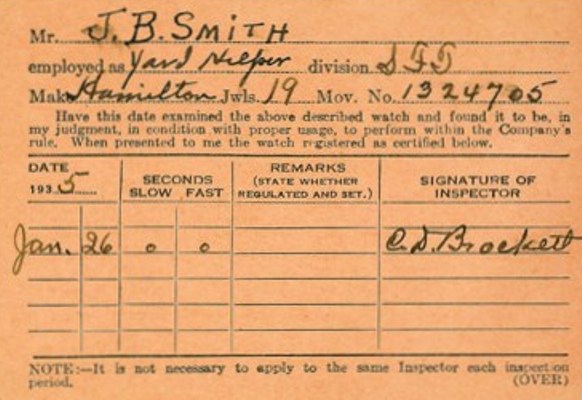 | |||
|
| Railway Historian IHC Life Member Site Moderator |
Reverse side 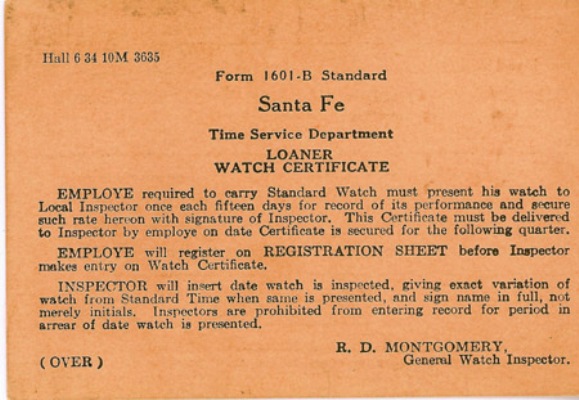 | |||
|
| IHC Member 163 |
It's interesting to see a 'yard helper' was required to carry a standard watch. Regard! Mark | |||
|
| IHC Member 1291 |
For those that don't know, "yards" were places on the RR system of tracks that commerce, interchange, storage, loading, unloading, repair and placement were performed on a large tract of land with multiple tracks and within "yard limits". A "helper" was usually one of two employees on the same crew along with a "foreman, engineer, and fireman" that assembled and made up freight and local trains generally working around the clock in 8 to 16 hour shifts. At some point in time a helper may be required to enter a piece of trackage known as the "main line" which was jointly shared with freight trains/crews and/or maintenance of way crews to add, deliver, assist, or to pick up boxcars. In entering that "main line", all employees governed had to have the standard watch, rule books, and keys to lock/unlock switches which connected to that main line. All that used or would use the main line generally could only enter at allotted times and report when clear of that main line so that traffic could resume and flow. "Railroading 101" regards, bb | |||
|
| Railway Historian IHC Life Member Site Moderator |
J.B. Smith's Illinois watch inspection card. 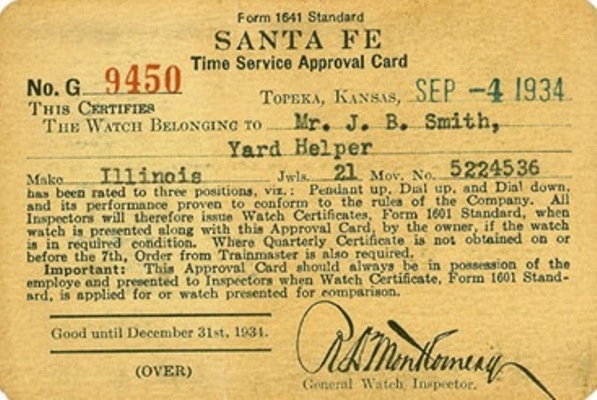 | |||
|
| Railway Historian IHC Life Member Site Moderator |
Santa Fe watch card reverse side.  | |||
|
| Railway Historian IHC Life Member Site Moderator |
On the CPR when I started at Alyth yard, Calgary, Alberta in 1973, I worked the spare board as a yardman or helper, we had two, and three man crews that consisted of a Yard Foreman, and two Yardmen or "Helpers" this was the normal crew with the Yard Foreman supervising, and the senior helper was called the long fieldman, when switching cars, riding cuts of cars to a coupling he would be the helper on the point of the movement relaying signals to the engineer, and the junior helper was called the engine follower, he would couple the engine to cars to be switched, and would always be close to the engine to relay signals to the engineer from the long fieldman when curvature or other conditions required him to be in position, sometimes riding high on top of boxcars, hand signals were used by daylight, and electric lantern signals by night. With the advent of portable radios many crews reduced to two men consisting of a Yard Foreman, and Yardman or helper, this was called the ground crew, and all assignments had a locomotive engineer, by my time all the yard firemen had gone through attrition, there were still some firemen positions on through freight, and passenger. At Alyth we had 70 yards assignments, some never left terminal working in the classification yard or on the hump, other assignments service industrial territories that involve doing out of the yard on to the main line, irregardless of whether you worked as a helper on a job inside the yard, or in industrial territories, all yardmen (helpers) were required to carry up to date railway grade watches and watch inspection certificates went on duty. One definition on the CPR for a "yard" was a system of rust controled by a fiendish yard master, who would not allow trains to depart or enter! Here is another one of J.B. Smith's watch certification cards for his Illinois watch.  | |||
|
| IHC Member 163 |
Well, my Dad started out as a 'yard helper' on the Norfolk and Western in 1948 before transfering to the time freight hump later that year, and worked in that position for 4 years. It even says 'yard helper/clerk' on his old railroad retirement papers in my Mom's safe deposit box. He was not required to carry or own a standard watch. He used his Lipton 15j wristwatch, which I now own. 'Railroading 101' is not all inclusive, but then we all know that undergraduate courses aren't meant to be. Thanks for the explaination of why one was required in yards. That makes sense. I'm guessing the reason he wasn't required to carry one was the two mainlines were located hard by the east end freight hump of the Portsmouth, Ohio yards, but the east end time freight yards did not intersect them at any point but at the extreme east and west ends of the yards. (I say 'yards' in plural, as they had a time freight classification yard and hump at the east end, and coal car hump and classification yard at the west end.) Portsmouth, Ohio was a terminal, and freight and coal trains were built in the 40+ track yard between the mainline and the floodwall at the river, so no thru mainline traffic was interferred with as it passed through town. A lot of passenger traffic came through town, and they didn't want freight car movement slowing their schedule through town. We had crack passenger trains like the Powatan Arrow and Pocohantas coming through the city limits doing 60-80 mph everyday! The last thing the N&W wanted was a schedule delay due to car movements in the yards onto the mainline in other than the limited access points. It might have been just yard specific for the N&W, as my Dad never left the Portsmouth yard his whole railroad career, as most yardmen didn't transfer far from the division. It was considered a good post/assignment, and many stayed there their entire railroad career. Anyway, it could be a single data point to the contrary of regular railroad practice, but still exists. For some reason on the N&W there was what the rule book stated, and what the individual division did. There was a lot of 'grey' area that was allowed to co-exist. To the topic, I have yet to see a loaner watch or inspection card from the local inspector, Jarvis Jewelers, ever show up to this day. I'm sure he had loaners too, as he was reponsible for not only the N&W, but B&O AND C&O, so he had his hands full with the inspection of 3 different railroads in our area. Regards! Mark | |||
|
| Railway Historian IHC Life Member Site Moderator |
There were lots of Yard Foreman and Yardmen (helpers) who worked in the captive CPR yard at Alyth who never carried their Approved Railway Grade pocket watches when on duty, they would leave them at home, and the yard master would always warn them when there would be supervisors around to check their watches, which they would bring in with their up to date watch card. I've seen some of these watches that were in beautiful condition hardly ever being worn, and I knew a couple of Yardmen. (helpers) who never owned a railway approved watch during their careers with a railway, they just played hide and seek and were never caught short. One Yard Foreman, Dick Jacobs who worked on the hump hated his job with the railway so much that he put his Bulova Accutron on the rail at the crest of the hump, before pulling the pin on his last car, and watch it get crushed as the steel wheels went over it. This is the way he finished his 40 years in the service of the CPR. | |||
|
| IHC Member 1541 |
This was a first generation portable on CN, it weighs 9 pounds! | |||
|
| Railway Historian IHC Life Member Site Moderator |
In the yard at Alyth we had smaller Motorola radios that you would wear in a holster with a belt around your waist with the small microphone like the one on Lorne's example. my second-generation caboose radio, in 1979 the CPR announced that they would abolish all rear end trainmen positions, so the conductor would be writing the caboose on his own, one stipulation of this change in working conditions required all caboose's to be equipped with an extra radio, this would be in addition to the radio that the conductor carried, and the head end trainmen would carry his own.  | |||
|
| Railway Historian IHC Life Member Site Moderator |
Microphone visible on conductors table in branch line caboose CPR 437169 at Alyth yard February 1974 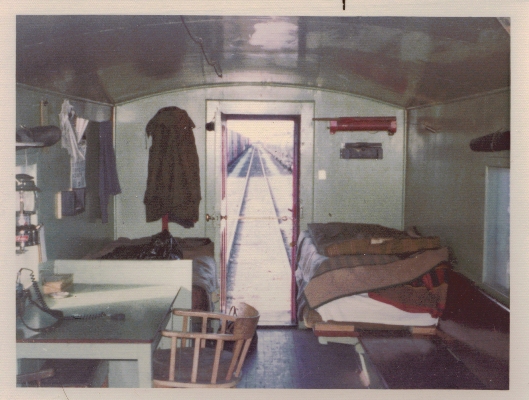 | |||
|
| Railway Historian IHC Life Member Site Moderator |
CPR first generation Motorola radios weighed about 15 pounds, were the size of a small briefcase, and had a microphone about the size of a tennis ball, there were still some in service when I worked out of Medicine Hat in 1973, I had one working a branch line job out of Swift Current, Saskatchewan it was a real pain to carry around when switching. All radios had Canadian Pacific, serial numbers that were recorded by the operators at every terminal.  | |||
|
| Railway Historian IHC Life Member Site Moderator |
A Motorola first-generation yard locomotive radio on a CPR DS-9 6700 series GM SW900 photo by Walter Kot, note the sash cord and wooden handle for locomotive whistle, rear and front headlight rheostat on cab wall. There was a speaker on the radio control box, and a channel selector to change yard frequencies. I worked on many of these locomotives earlier in my career in engine service, and later on in my career working through freight on larger General Motors 3000 hp locomotives, I found the noise level in the cab caused much fatigue, and I started to whear custom-made ear protection last 10 years that I worked, this probably saved me from irreversible ear damage, I had the opportunity to run one of these yard engines and couldn't believe the noise level in the cabs of these diesel locomotives. 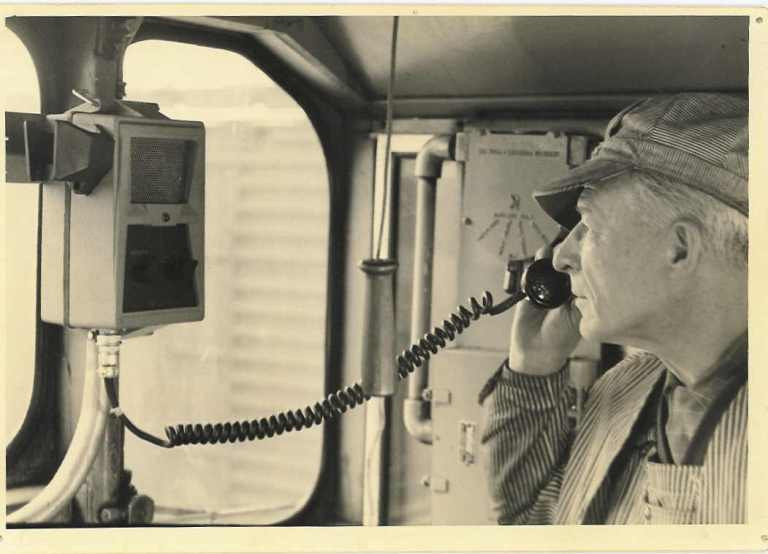 | |||
|
| Railway Historian IHC Life Member Site Moderator |
Here is a Motorola handheld radio, a CPR Yardmaster Ed Woelk is using it circa 1968, photo by Walter Kot. Ed is using a push button on the side to communicate, the ones we used in the yard had a microphone on a spiral cord that screwed into the top. 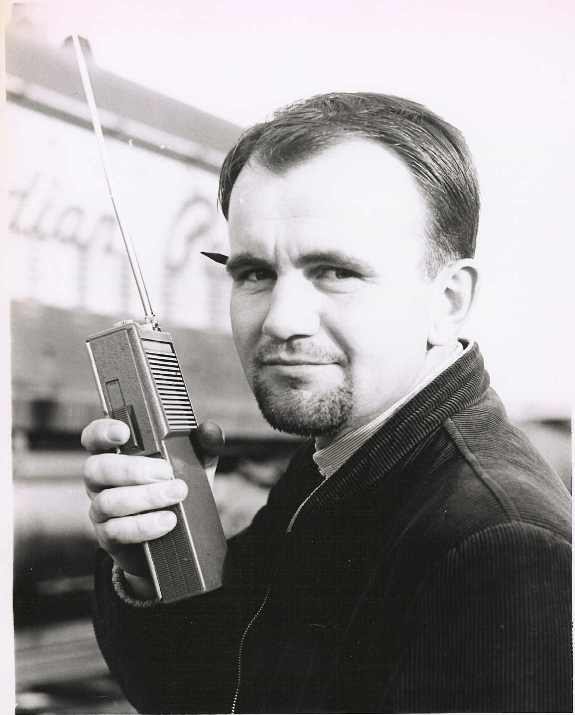 | |||
|
| IHC Member 1110 |
Thanks to everyone,a collection of those inspection cards is nice to have!I notice on Larry's Santa Fe card that they only checked that 21J Illinois for 3 positions instead of the usual 5, even though it was in the 30's.Also wonder if R.D. Montgomery was related to H.S. Montgomery who invented the Montgomery dial.I think RR time inspection is pretty fascinating.David Nicholson wrote a nice Santa Fe RR watch inspection book I read years ago, it's worth a read if anyone's interested.Wouldn't it be cool if you had an inspector card for every railroad watch you own!Thanks again, Ted. | |||
|
| Railway Historian IHC Life Member Site Moderator |
I have a copy of David Nicholson's Santa Fe Railroad Watch Inspection Service, I believe R.D. Montgomery was related to H.S. Montgomery, I will take a look at my book this afternoon to confirm this. | |||
|
| IHC Life Member Site Moderator |
Henry S. Montgomery (June 1856-Dec 1927) had a son Ralph D. Montgomery (born in 1878). In the 1900 census for Topeka Ks. Henry is listed as time inspector and Ralph as assistant time inspector. This image of from the June 1910 Santa Fe magazine  | |||
|
| IHC Member 1110 |
Thanks Tom!...Ted. | |||
|
| Railway Historian IHC Life Member Site Moderator |
The Precision Clock acquired by H.S. Montgomery to protect against interruptions of time signal sent daily by Western Union. Standing by the clock is believed to be Ralph D. Montgomery eldest son of H.S. Montgomery. This picture was taken in the early 1900s. From David M. Nicholson's book Santa Fe How It Governed Its Timepieces Throughout the System 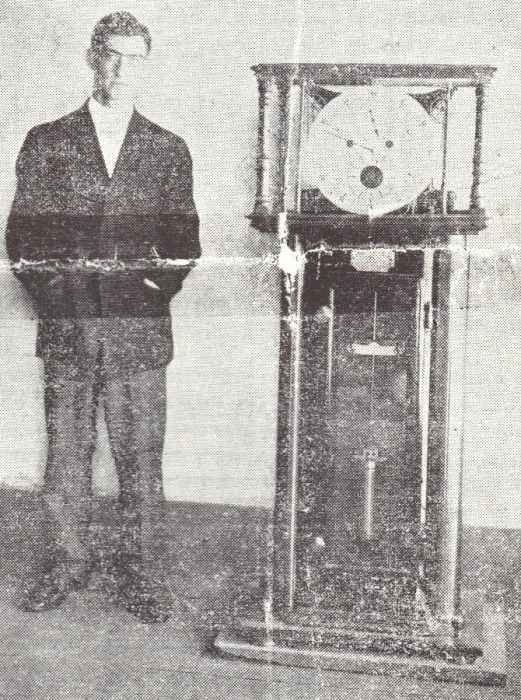 | |||
|
| IHC Life Member Site Moderator |
Here is his WWI Draft card, his middle name was DeWitt. 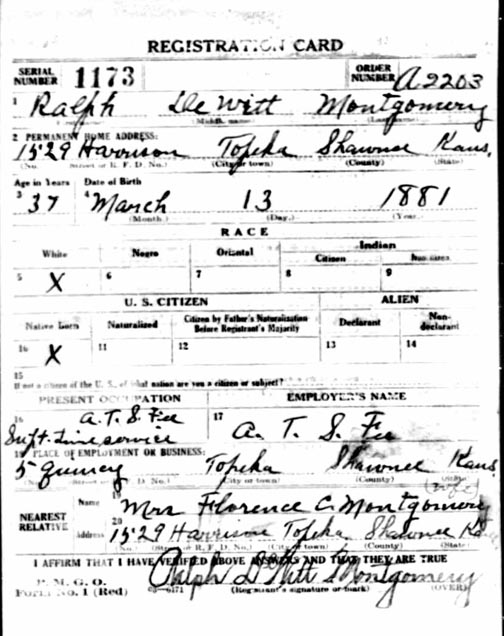 | |||
|
| Railway Historian IHC Life Member Site Moderator |
Book cover  | |||
|
| Railway Historian IHC Life Member Site Moderator |
Ralph D. Montgomery was named successor of his father on, January 1, 1924 in the capacity of general watch and clock inspector. First taking up the watchmakers trade under his father he had been afforded a wonderful opportunity to study the changing needs of the railroad from first-hand experience. After graduating from the Peoria, Illinois Horological School he was put to work as a traveling clock inspector and various other capacities, before being promoted to Assistant General Watch Inspector. At the time R.D. Montgomery took over the time service department all watches under Santa Fe inspection were being cleaned and freshly oiled every 15 months. In 1938, R.D. Montgomery designated a standard watch as: American make, 16 size, lever setting, 19 jewels or more, winding at 12 page too'clock, double roller escapement, steel escape wheel, adjusted to five positions, temperature and isochronism, and with a variation, not exceeding six seconds in seventy two hour tests in three positions. And the watch to be regulated to run within a variation not exceeding thirty seconds per week. From David M Nicholson's book Santa Fe How it Governed its Timepieces Throughout The System 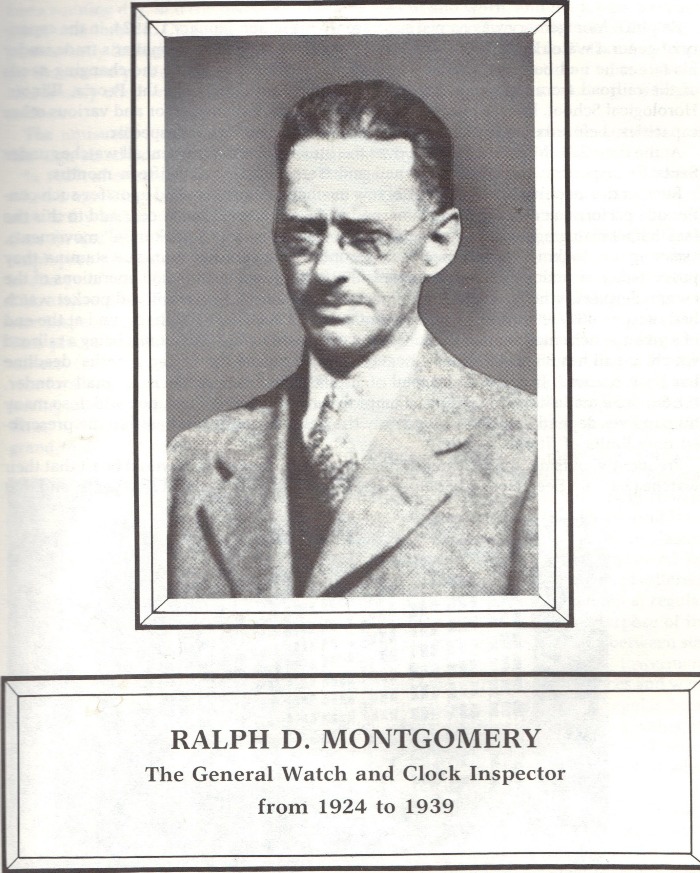 | |||
|
| Railway Historian IHC Life Member Site Moderator |
I have another watch inspection card from J.B. Smith from the 1960s, he is now working for the Rock Island Railroad in the yard in Chicago, and is now using an Elgin BW Raymond  | |||
|
| Railway Historian IHC Life Member Site Moderator |
Reverse side of JB's watch inspection card, he must've been working out of Joliet, looking at the address on the front of the card.  | |||
|
| Railway Historian IHC Life Member Site Moderator |
Standard Loaner Card from Nickel Plate Road (Wheeling and Lake Erie District.) from the 1950s with instructions for the Local Watch Inspector to forward it to Ball Railroad Time Service, General Time Inspector, Cleveland, O. 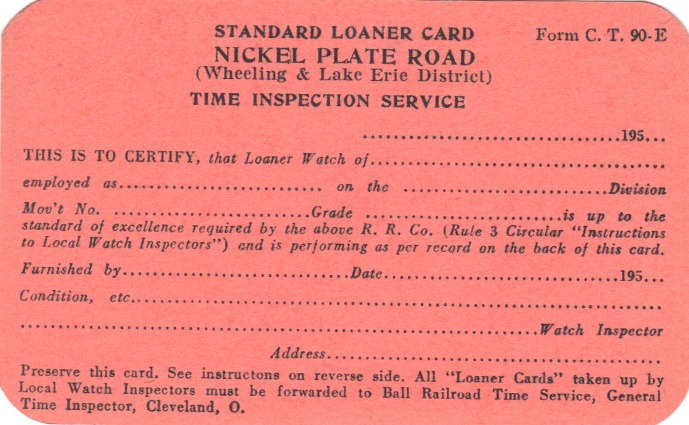 | |||
|
| Railway Historian IHC Life Member Site Moderator |
Nickel Plate Road Loaner Watch Inspection Card reverse side 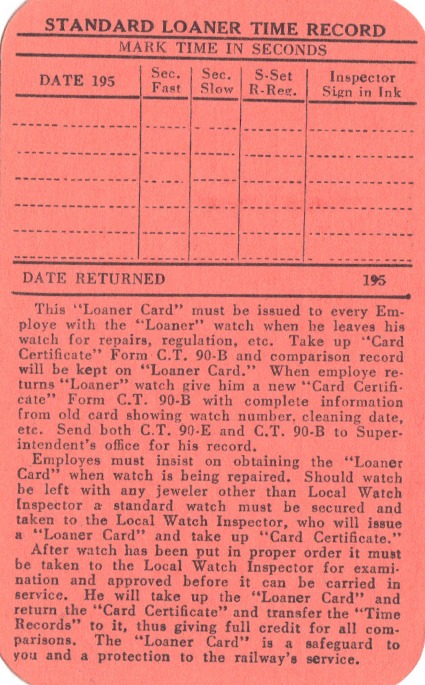 | |||
|
| IHC Member 1110 |
Thanks to Tom and Larry...I found my copy of Nicholson's Santa Fe book.Old J.B. was was around for a long time!I notice the BWR was a "late model" Elgin.Maybe his older Illinois was no longer allowed by Rock Island rules?The blank loaner card of Larry's pretty much says it all.Thanks again, Ted. | |||
|
Thank you all for the lesson on this subject. Great information. | ||||
|
| IHC Life Member |
Very interesting thread. Thanks to all who contributed. | |||
|
| Powered by Social Strata | Page 1 2 |
| Your request is being processed... |
|
©2002-2025 Internet Horology Club 185™ - Lindell V. Riddle President - All Rights Reserved Worldwide

